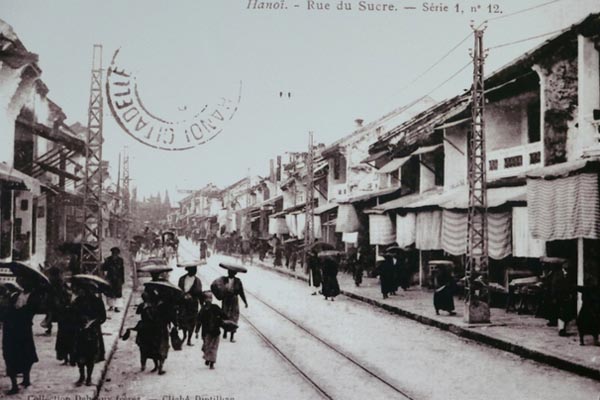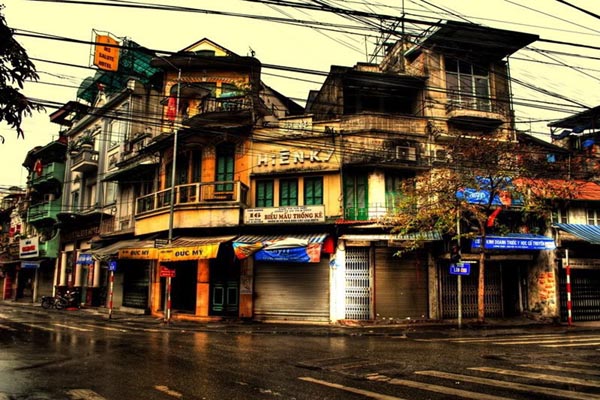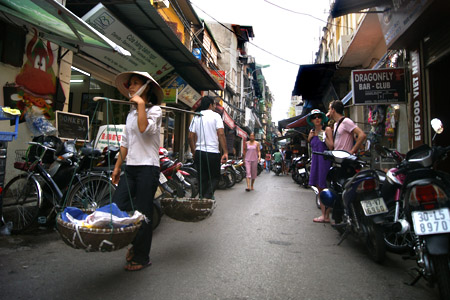A thousand years ago, the embryo of Hanoi was a cluster of villages. Some twenty years ago, in spite of the attempts at urbanization - first by the colonial administration early in the century, then by the national government since the end of the first Indochina war, the town still kept its rural look. Some foreign tourists were apt to say "A big village!"
Nothing surprising, the streets in the oil quarter of Hanoi, the quarter of the "thirty-six streets and guilds" - which started shaping up in the 15th century, still keep the evocative names of people’s villages of origin — Phat Loc, To Tich, Chan Cam..., or of villages founded by people engaged in the same trade or craft: Silk Street, Copper Street, Dyers’ Street, Vermicelli Street, etc.

Today traces of the mentality of villagers are visible in the more or less anarchic character of the inhabitants and especially in their behavior in the street. This character has been aggravated by the economic renovation (adoption of the market economy, opening up to foreign capital) which has provoked a stunning commercial effervescence and building boom (houses, hotels, restaurants, factories). At the cross-roads, even when the red traffic lights are on, people who are in a hurry pass nonetheless. In the rush hours it is a mad onrush of bicycles, motorbikes, cars, and pedicabs (two-thirds at least of whose drives come from the countryside). In periods between harvests, peasants from the outskirts come to the city in hope of getting some kind of employment. Street pavements are invaded by peddlers and itinerant vendors, most of them being women villagers from the periphery. In vain do street wardens try to remind litter-louts that they must not throw odds and ends about at random, as they would feel free to do in a rural lane.
Following the latest administrative re-arrangements (1997) the capital city comprises the city proper with seven urban districts (Hoan Kiem, Ba Dinh, Hai Ba, Dong Da, Tay Ho, Thanh Xuan, Cau Giay) and a rural suburb with five suburban districts (Thanh Tri, Tu Liem, Gia Lam, Dong Anh, Soc Son). The city proper (about 82 sq kilometers in area) is one-tenth the size of the peripheral suburb (about 847 sq kilometers). The populations of the two are about equal (city: 1,256,000; suburb: 1,143,000).

That structural imbrications of town and village explains the complexity of the situation on the economic and human levels. There were times, during the period of brisk collectivization and the American war when town-dwellers were forced to go and live in rural areas when people spoke of the "ruralization" of Hanoi. The peasant way of life invaded the city. For a decade now, the reverse has been taking place. With the progress of "urbanization", the face of the traditional villages of the periphery has changed a great deal. Thatch huts have all but disappeared, their place taken by brick cottages of a hybric style. A rat race is under way and an ever deeper gap separates the rich and the poor. Urbanization has reduced the arable area, land being reserved for the construction of plants, public services, and residences. It aggravates flooding (filling up of lakes and ponds) and environmental pollution. But it also has a positive side. It creates markets for agricultural produce, which is all the more useful since suburban agriculture has recorded in the late 1980's encouraging successes and has brought about an increase in the utilization coefficient of land, better output for rice and other crops, a larger income per ha of land and an improvement of the peasant’s standard of living. Urbanization creates a demand for labor (emergence of mercantile agriculture, an impulse given to animal husbandry, especially fish- rearing, development of sideline crafts).
The urbanization of Hanoi must aim for a balance with agricultural development and take into account the cultural and eco-logical heritage of villages.



